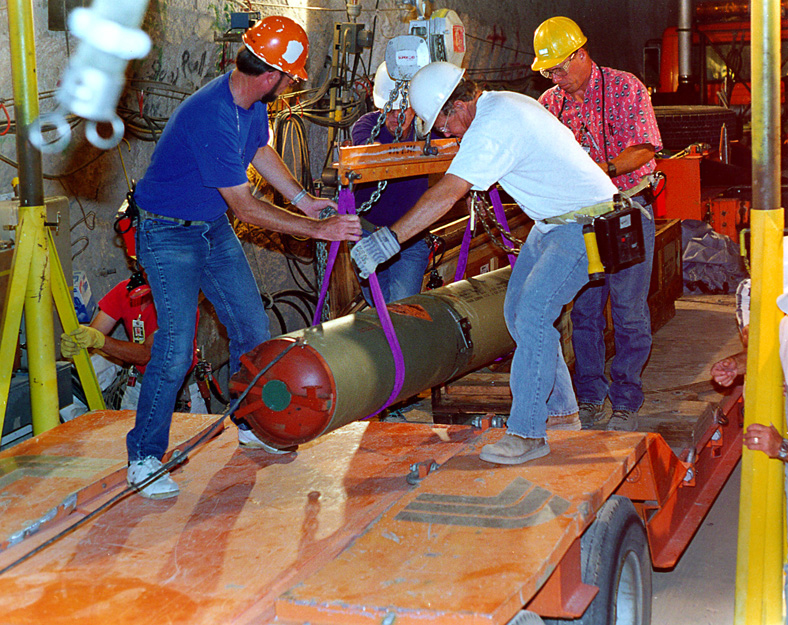
Trying to determine the nature of the air and ground emissions released during disposal of excess munitions through open burning or open detonation, researchers from Sandia National Laboratories and other labs have begun a series of tests inside a sealed, underground chamber at the Nevada Test Site.
The tests are taking place in the X-tunnel complex. Built in the early 1980s for ballistics studies, the X-tunnel complex features a ballroom-sized chamber at the end of a 600-foot-long tunnel. Besides Sandia, Lawrence Livermore (LLNL) and Los Alamos (LANL) national laboratories are participating in the tests under the direction of the Nevada field office of the Department of Energy, with assistance from Bechtel Nevada and Radian International.
Carefully encased laser diagnostics have been designed and installed by a Sandia team. These diagnostics were used to monitor the formation and potential release of hazardous gases, such as carbon monoxide and hydrogen cyanide, in seven tests earlier this year involving artillery shells and rocket motors. The data have been compiled and are now being analyzed.
In the past, said Joel Lipkin, who manages Sandia’s participation in the project, researchers have only been able to collect gas and particulate emission data from very small-scale explosive detonation or propellant burn events. “Since these laboratory tests usually involve only a few grams of material, the results could not be easily related to the real world situation where hundreds or thousands of pounds of material are generally detonated or burned in a single event,” he said.
In the first test in December 1996, called “Banshee”, six artillery shells containing 100 pounds of explosives were set off. In January, “Polaris” exploded 24 shells carrying nearly 500 pounds of explosives. “Beast” involved the same amount of shells and explosives in February. In March, “Colossus” consumed 60 shells containing 1,000 pounds of explosives.
Starting in May, the test chamber in X-tunnel was used to determine the emissions from burning rocket motor propellants. Two Nike rocket motors containing a total of 1,500 pounds of a nitrocellulose/nitroglycerin based propellant were burned in a test called “Sunspot,” then four Nike rocket motors with 3,000 pounds of propellant were burned in “Thunderbird”. Finally, two Improved Hawk rocket motors with 1,200 pounds of ammonium perchlorate-based propellant were burned in June in a test called “Dazzler”.
“Because Sandia had previously worked to reduce its inventory of excess rocket motors, Sandia had lead responsibility for the rocket motor burn tests at X-tunnel,” Lipkin said. Sandia was responsible for installing and detonating the various explosives used in the detonation tests as well as those used to split open the metal casing of the rocket motors and initiate the propellant burns.
The “ballroom” was sealed during the tests, and the burns were videotaped from a port in the entry. “Dazzler” got its name from the bright flame produced by the burning propellant. A day after the test, workers were required to wear respiratory gear to re-enter the sealed chamber once it had cooled. Dazzler was the last test conducted in this series because the burning rocket motor propellant required extensive clean-up operations at X-tunnel.
The artillery shells were detonated on a concrete pad or bed of gravel which pulverized in the explosion. About 75 pounds of steel in the case of each shell was turned into shrapnel that blasted limestone debris from the walls of the tunnel in the detonations. No shrapnel was produced during the rocket motor burns, but the burning propellant released large quantities of gas and soot.
Installing and protecting sophisticated instruments in this harsh environment was a challenge. The laser hardware was encased in a metal box secured to the rock in the test chamber. Laser light passed through windows in the box into the gases in the chamber. A stream of nitrogen gas cleared sticky debris from the windows.
The laser beams were selectively absorbed by gases produced by the detonations and burns in the test chamber. The chemistry changes rapidly as hazardous materials are produced by incomplete combustion, Lipkin said. Signals from these compounds are relatively weak in this setting and require a fairly sensitive monitoring system to detect.
LANL gathered particulate measurements, using a specially designed real-time impact detector. LLNL conducted gas chromatography and mass spectroscopy, analyzing the depletion of oxygen in the chamber and the concentration of various gases including carbon dioxide and oxides of nitrogen.
The next series of tests, due to begin in 1998, will be based on experience with how the facility and systems worked in this initial series, Lipkin said. A variety of different types of tests are foreseen for several years to come. The X-tunnel tests are being carried out as part of an agreement between the DOE and the Department of Defense Joint Service Demilitarization Technology Office in Savanna, IL.
Sandia is a multiprogram Department of Energy laboratory, operated by a subsidiary of Lockheed Martin Corp. With main facilities in Albuquerque, N.M., and Livermore, Calif., Sandia has major research and development responsibilities in national defense, energy, environmental technologies and economic competitiveness.
Technical contact:
Joel Lipkin, jlipkin@sandia.gov, (510) 294-2417